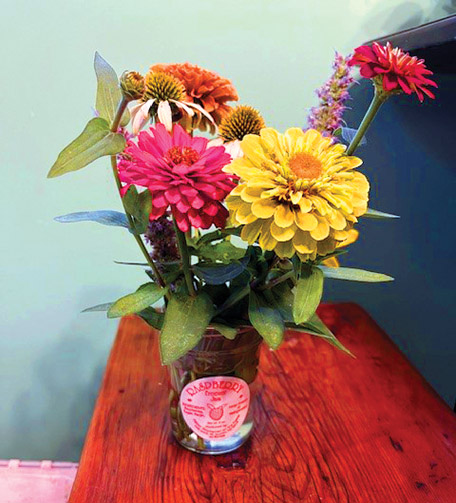Talking Plants
Jillian Patrie | University of Minnesota Yard and Garden Extension
Now that gardens are growing produce and flowers are ready to be cut, how can we keep everything going until we see our first frost? What are some ways we can use what we pick and cut from gardens to bring the outside in? Here are some ideas on using the items we harvest from our green spaces.
Vegetables are the most common items that are harvested and used throughout the year. Depending on what you are growing, things can be used fresh or preserved. Cucumbers can be sliced and eaten right from the garden, or they can be made into canned or refrigerated pickles. Tomatoes are grown by many for multiple uses such as salsa, spaghetti sauce, pastes, or eating from the vine. Peppers that are hot and spicy are perfect for salsa or drying for spices. Sweet peppers are great roasted on the grill, fried or eaten fresh on a salad or with dip. Growing green beans? Did you know that purple bush beans will turn green when they are boiled? Green beans straight from the garden or blanched and frozen are a garden staple for many. Summer isn’t summer without fresh corn on the cob, in July and August we start to see sweet corn being sold on the roadside. Sweet corn can be roasted on the grill or fire, boiled or blanched and frozen for year-round use.
As vegetables & fruits in gardens ripen, there are some things to be on the lookout for. Tomatoes can experience blossom end rot as they mature and ripen. This issue stems from water moisture and temperature fluctuations, which causes the tomato to rot from the bottom (blossom end). To help prevent this issue, maintain even soil moisture and temperature by adding mulch around tomato plants and keep watering on a consistent schedule. Peppers can also experience blossom end rot, as well as sun scald and splitting, when the fruits grow too quickly, or the sun is intense. Be on the lookout for garden pests such as Colorado potato beetle, aphids and caterpillars that may be snacking on leaves.
Garden flowers like zinnia, cosmos and marigolds are starting to bloom and they are great cut flowers. Many garden flowers will continue to bloom all summer long, and with proper harvest and fertilizing they will last until the first frost. Cut flowers are an important part of gardens and landscapes, they not only bring beauty but also food for native pollinators. Consider adding a few pockets of annual and perennial flowers into your garden and landscape to help with pollination, pollinator health and beautification.
Herbs are another garden staple, used for cooking, soaps and teas. Many herbs are perennial, and if planted in the ground will come back each year. Mint, oregano and thyme can come back from the roots and cilantro and dill will reseed if the seeds are left in the fall. Herbs can be grown indoors successfully with supplemental light during the winter months.
A garden will continue to provide produce and flowers throughout the growing season, with proper maintenance. There are many ways to utilize your garden harvest, whether vegetables, fruits, herbs or flowers.
Visit University of Minnesota Extension at https://extension.umn.edu/how/using-your-harvest. For more information on harvesting and using garden produce. For local yard and garden questions, contact your Clay County Extension Educator Jill Patrie at 218-299-7338 or by email at patri350@umn.edu.


